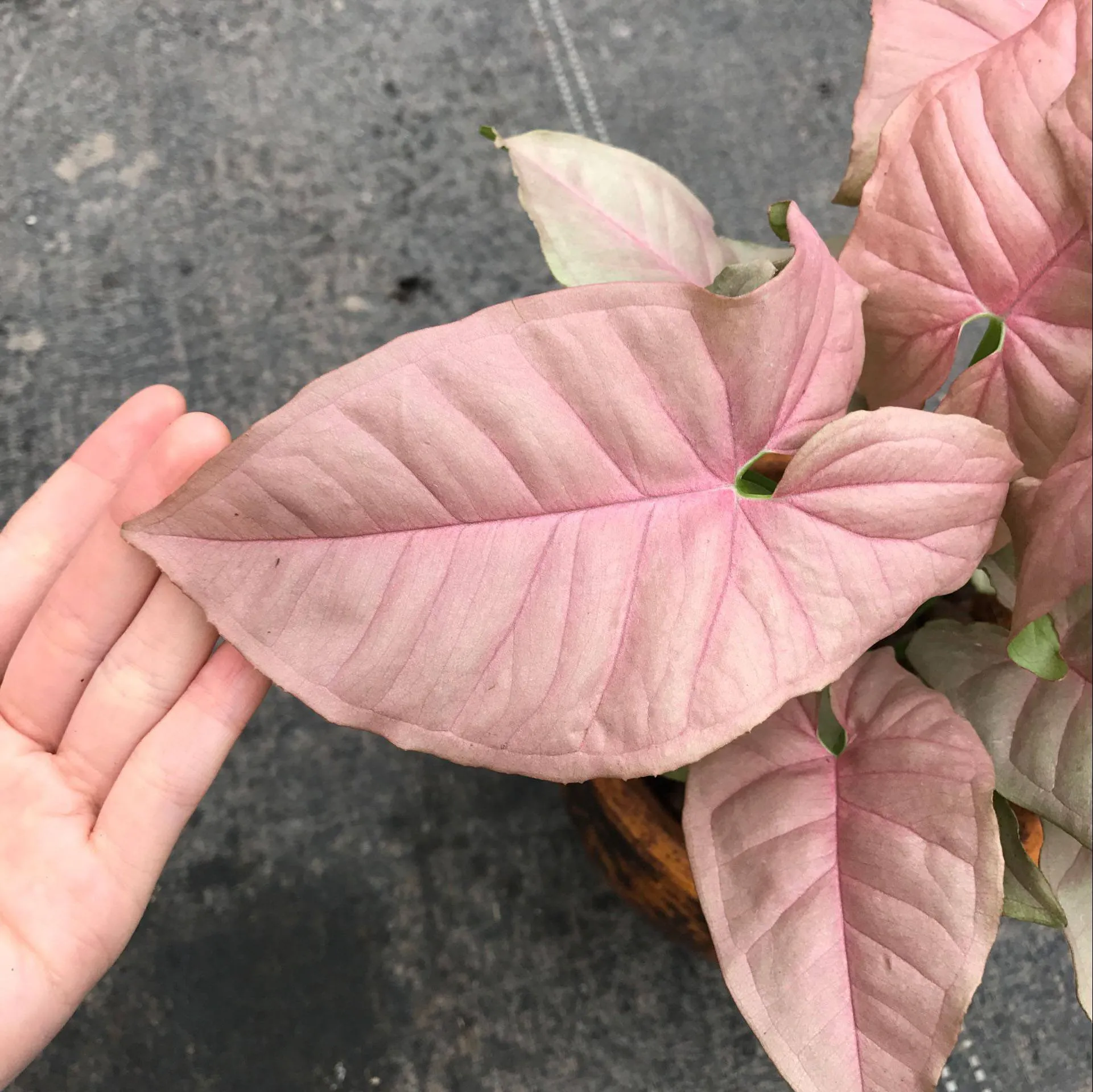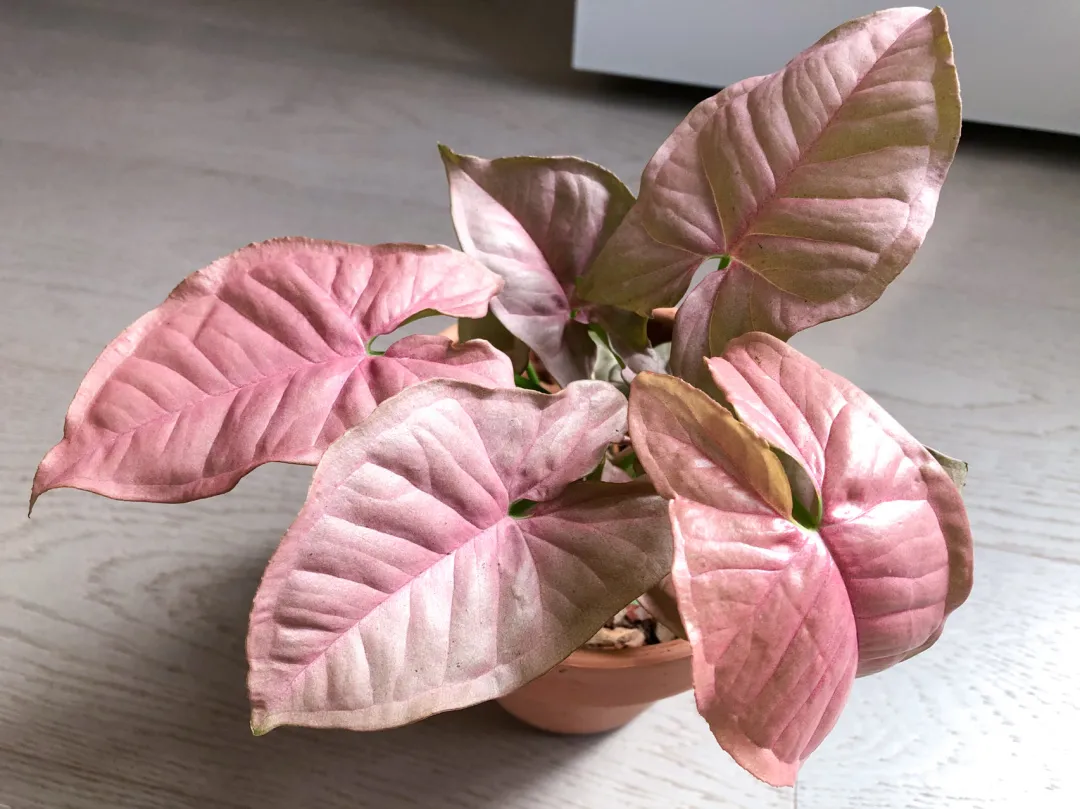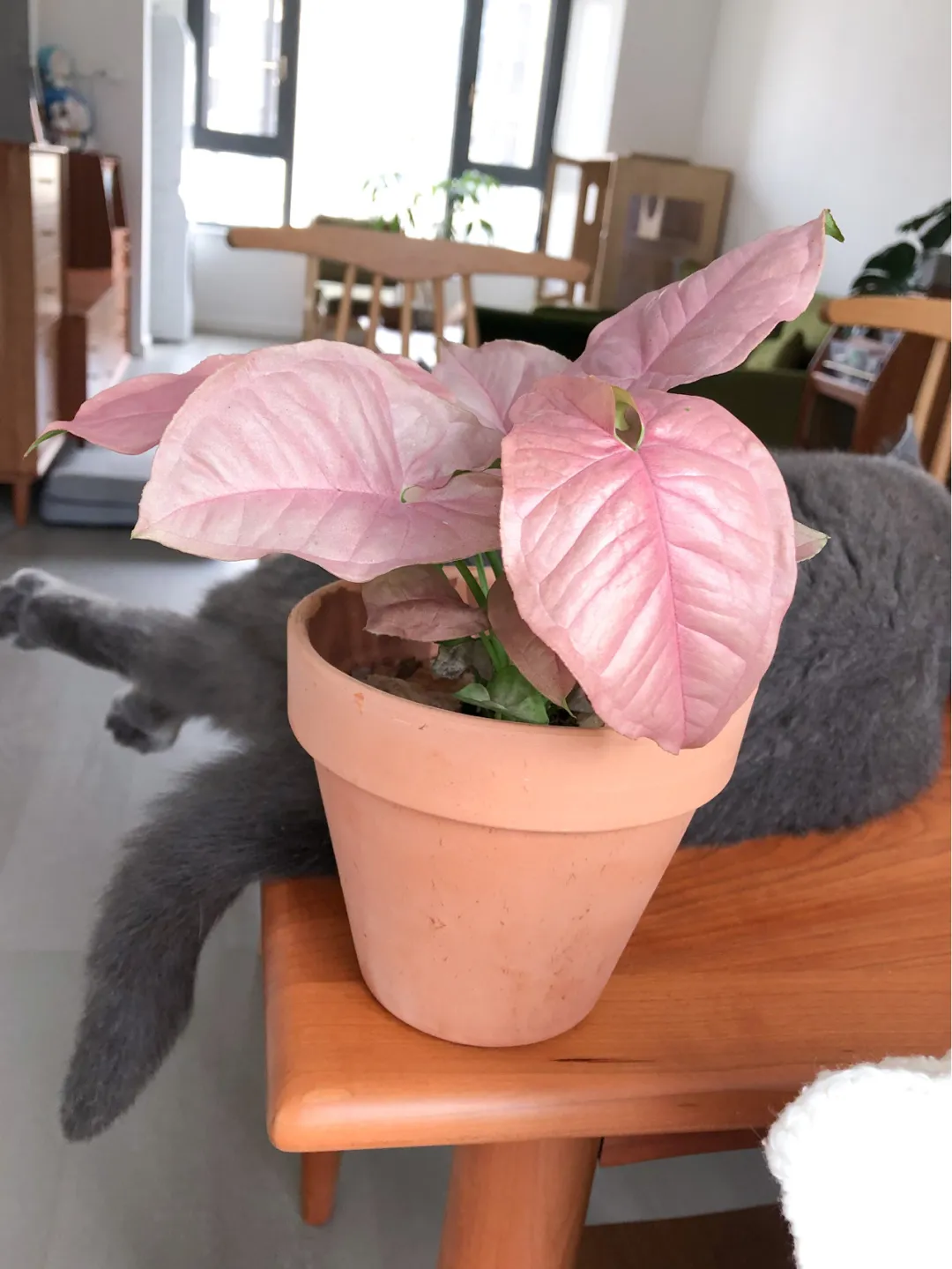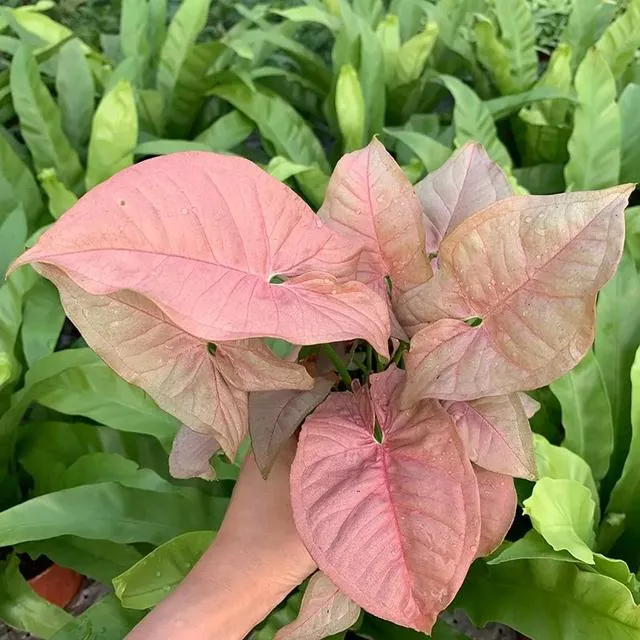How To Take Care Of Pink Syngonium (Syngonium Podophyllum)
Written by Ivy
Dec 09 2021

Pink Syngonium, also called pink allusion arrowhead plant is a perennial evergreen herb. The basal leaves of pink Syngonium are shield-shaped, arrow-shaped, or heart-shaped, green, with white, pink, crimson and other color spots, the Buddha flame bud is green, and the upper part is green and white, in shell shape.
Pink Syngonium leaves grow from tubers, oval or heart-shaped, with thousands of color changes. There are red veins inlaid with green, red veins and green leaves, red veins with spots, green veins and red spots. Some leaves are pure white, leaving only green veins or red veins, and some green leaves are covered with paint or watercolor spots.
Summer is the main viewing period of pink Syngonium, and the colorful leaves are full of coolness. Pink Syngonium people's autumn leaves are gradually disordered, their leaves wither and yellow in winter, enter the dormancy period, and begin to sprout and grow again in late spring and early summer. From May to September is the vigorous growth period of pink Syngonium and we need to take good care of pink Syngonium to show its best-viewing state. Let's take a look at the specific requirements for taking care of pink Syngonium.
 Pink syngonium is a perennial trailing evergreen herb. Stem nodes have aerial roots and grow by climbing others. The leaves of pink Syngonium are of two types, and the young leaves are single leaves, arrow-shaped or halberd-shaped. The old leaves of pink Syngonium form 5-9-lobed palmate leaves, the middle leaf is large, and small ear-shaped leaves are often found on both sides of the leaf basal lobes. Pink Syngonium leaves are arrow-shaped and divided, with pink veins and green petioles.
Pink syngonium is a perennial trailing evergreen herb. Stem nodes have aerial roots and grow by climbing others. The leaves of pink Syngonium are of two types, and the young leaves are single leaves, arrow-shaped or halberd-shaped. The old leaves of pink Syngonium form 5-9-lobed palmate leaves, the middle leaf is large, and small ear-shaped leaves are often found on both sides of the leaf basal lobes. Pink Syngonium leaves are arrow-shaped and divided, with pink veins and green petioles.


If there is no improper watering, it may be caused by the lack of nitrogen in the soil. You can supplement it with some thin fertilizer to restore pink Syngonium to a healthy state.
If the leaf edge of pink Syngonium turns yellowish-brown or brown, it will also be caused by water shortage or low air humidity. During the growing season, it can occasionally increase ambient humidity around the sprayed water, and soil does not often dry.
During the growth of pink Syngonium, we should apply fertilizer in time, but we can't apply concentrated fertilizer at one time to avoid root burning. Pink Syngonium is a typical acid soil plant. If you encounter these problems during growth, you must solve them in time.
Pink Syngonium leaves grow from tubers, oval or heart-shaped, with thousands of color changes. There are red veins inlaid with green, red veins and green leaves, red veins with spots, green veins and red spots. Some leaves are pure white, leaving only green veins or red veins, and some green leaves are covered with paint or watercolor spots.
Summer is the main viewing period of pink Syngonium, and the colorful leaves are full of coolness. Pink Syngonium people's autumn leaves are gradually disordered, their leaves wither and yellow in winter, enter the dormancy period, and begin to sprout and grow again in late spring and early summer. From May to September is the vigorous growth period of pink Syngonium and we need to take good care of pink Syngonium to show its best-viewing state. Let's take a look at the specific requirements for taking care of pink Syngonium.
Pink Syngonium Quick InfoWhat Does a Pink Syngonium Look Like?How to Care for Pink Syngonium?WaterLightSoilTemperatureHumidity FertilizerRepotPrunePest & Disease ControlWhy do Pink Syngonium leaves turn brown?Why are my Pink Syngonium leaves turning yellow?Why does my Pink Syngonium leaves drooping?
Pink Syngonium Quick Info
| Botanical/Scientific Name | Syngonium Podophyllum |
| Common Name | Pink Syngonium, Arrowhead Plant, Pink Allusion Arrowhead Plant |
| Uses | Cleanse the air, breathe and act as anti-pollutants |
| Origin | Native from Mexico to Ecuador |
| Light Care | Medium-light |
| Soil Care | Light soil mixture |
| Temperature Care | 60-80°F |
| Humidity Care | High humidity (60-90%) |
| Watering | Water regularly |
| Pruning Care | Regular pruning |
| Fertilizer Care | Organic liquid fertilizer |
| Propagation | Stem cuttings |
| Toxic | Toxic to both humans and animals |
What Does a Pink Syngonium Look Like?

How to Care for Pink Syngonium?
Water
Pink Syngonium prefers slightly wet soil. During maintenance, water regularly to keep the soil of pink Syngonium slightly wet. The specific watering frequency needs to be adjusted according to the season and the drainage of the soil used for breeding. In other words, we can properly water more in spring and autumn and less in winter. If the soil drainage is good, we can increase the watering frequency. If the soil drainage is poor, we should reduce the watering frequency.Light
Pink Syngonium has strong adaptability and healthy growth, and can adapt to different light environments. The stems and leaves in strong light are slightly lavender, and the leaves are large and light in color. If pink Syngonium grows in weak light, the leaves are narrow and dark. It grows well in the bright scattered light, and it is appropriate to block 50% of the light.
Soil
The cutting soil of pink Syngonium basin is usually composed of sapropel, peat soil and a small amount of coarse sand or perlite. Meanwhile, pink Syngonium is also suitable for soilless culture, especially sand culture and nutrient solution culture.Temperature
Pink Syngonium is suitable for growing in a relatively warm environment. We can control the temperature between 20-30 ℃ during pink syngonium care. This can speed up its growth and make it grow up quickly. In winter, pay attention to keep warm and don't let the temperature be lower than 15 ℃.Humidity
Pink Syngonium needs high humidity. We should often spray water and water to humidify the plant or growth environment during pink syngonium care. It should be maintained at about 40% - 50%.Fertilizer
Pink Syngonium does not have high demand for fertilizer and is suitable for planting with loose, fertile and well drained sandy loam. During the growth period of pink Syngonium, we can apply compound fertilizer or cake fertilizer and water every half a month, mainly nitrogen fertilizer, to supplement nutrients for pink Syngonium.
Repot
When we take care of pink Syngonium, we should avoid changing pots frequently. Its growth rate is very slow. It does not need to change pots every year. Generally, it is enough to change pots every three years or so. Its lateral buds grow more, and can also be planted separately in new flower pots. Each time we change pots, we can change a slightly larger container. The flower pot for planting pink Syngonium can be a hanging pot or a plastic pot. There is a large drainage hole at the bottom, which is beneficial to its growth, that is, to avoid excessive moisture in the soil.Prune
At the seedling stage of pink Syngonium, we are required to remove the top bud to remove the top advantage, so as to make pink Syngonium grow fuller and promote the germination of new buds during pink syngonium care. During the growth period, the plant will grow faster. Cut off the new buds and redundant branches in time to reduce nutrient consumption.Pest & Disease Control
If pink Syngonium is prone to leaf spot in a high humidity and non ventilated environment, once we observe that pink Syngonium has leaf spot, we need to cut off the affected leaves and spray methyletobuzine wettable powder on the plants to prevent leaf spot during pink arrowhead plant care.Why do Pink Syngonium leaves turn brown?
If we find that the leaves of pink Syngonium turn brown, it is generally caused by improper watering. If the soil is dry for a long time, the leaves at the bottom of branches will turn yellow and wither. If we water too much, the leaves will turn yellow, which will lead to rhizome decay in serious cases.If there is no improper watering, it may be caused by the lack of nitrogen in the soil. You can supplement it with some thin fertilizer to restore pink Syngonium to a healthy state.
If the leaf edge of pink Syngonium turns yellowish-brown or brown, it will also be caused by water shortage or low air humidity. During the growing season, it can occasionally increase ambient humidity around the sprayed water, and soil does not often dry.

Why are my Pink Syngonium leaves turning yellow?
The reason why pink Syngonium leaves turn yellow is due to insufficient light or excessive watering. Of course, it may also be a combination of the two factors. If we keep the fruit taro in a dark place, the leaves will lose color, the gap between stems and leaves will continue to lengthen, and the leaf color will be extremely dim. At this time, we need to move it to a slightly brighter position in time. But be careful not to be exposed to the sun all at once. Gradually increase the light to avoid sunburn on the leaves.Why does my Pink Syngonium leaves drooping?
If you water too much and frequently during the growth of pink Syngonium, it is easy to cause the leaves to fall. Generally speaking, the old leaves do not change much. If it is caused by water shortage and drought, the most significant feature is that the leaves of pink Syngonium will turn yellow from bottom to top. If the water shortage is serious, it is easy to cause its death. If too much fertilizer is applied during the growth of pink Syngonium, it is easy to cause the young leaves of pink Syngonium to become thick, uneven and yellow. During the growth time of pink syngonium, if too little fertilizer is applied, pink Syngonium can not absorb nutrition for a long time. Of course, it grows very badly. The young leaves and young stems turn yellow first. If nutrients are not supplemented in time, the leaves will fall and die.During the growth of pink Syngonium, we should apply fertilizer in time, but we can't apply concentrated fertilizer at one time to avoid root burning. Pink Syngonium is a typical acid soil plant. If you encounter these problems during growth, you must solve them in time.
Latest Updated
- Benefits of Bugleweed - 7 Science-backed Health Benefits
- Bugleweed Dangers & Side Effects - Is It Poisonous?
- How to Plant Evergreen Trees - What You Should Know
- When to Plant Evergreens - Grow Guide for Evergreen Trees
- 12 Wonderful Evergreen Shrubs for Your Garden
- 12 Popular Evergreen Plants with Pictures for Beginners
- When And How To Prune A Lilac Bush Like a Pro
- How to Grow & Care for Lilac Vine (Hardenbergia Violacea)
- Japanese Lilac Tree (Syringa Reticulata) Care & Propagation Guide
- Shumard Oak Pros and Cons - What to Know
Popular Articles
- Winter maintenance of Antirrhinum Majus
- How to Grow Terminalia Mantaly Tree
- How to Grow and Care for Crossostephium Chinense
- How to grow Antirrhinum Majus in spring
- Peristeria Elata (Dove Orchid) Profile: Info & Care Guide
- Underwatered Snake Plant (Sansevieria Trifasciata) - Signs And How To Fix
- How to Care for Brazilian Jasmine Plant (Mandevilla Sanderi)
- How to Grow & Care for Graptopetalum Purple Delight in Summer
- Rosa Chinensis (China Rose): Plant Growing & Care Tips
- How to Care for Baby Sun Rose (Aptenia Cordifolia)